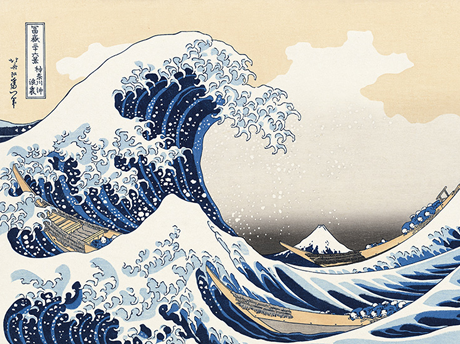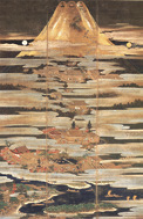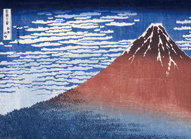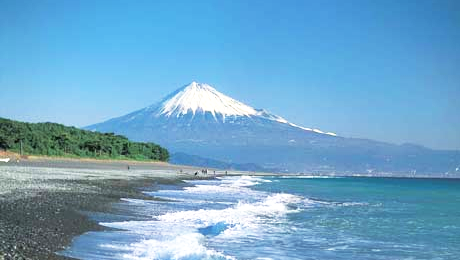Home > Value of Mt. Fuji
Main content starts here.
Value of Mt. Fuji
Mt. Fuji, a beautiful active volcano that symbolizes Japan, was called "Fujisan, Sacred Place and Source of Artistic Inspiration" and added to the World Heritage List as a cultural property during the 37th session of the UNESCO World Heritage Committee. Here we introduce the outstanding universal value of Mt. Fuji, which has been recognized as a global treasure that should be passed onto future generations.
World Heritage Site: Fujisan Sacred Place and Source of Artistic Inspiration
Fujisan is an active volcano which, at 3,776 meters, is the highest peak in Japan. At the 37th World Heritage Committee Meeting held in June 2013, Fujisan was inscribed in the World Heritage List as "Fujisan – Sacred Place and Source of Artistic Inspiration". Reasons for its inscription include the large influence of Fujisan on the Japanese people's view of nature and on Japanese culture as an "object of worship" and a "source of artistic inspiration".
Once feared for its repeated eruptions, Fujisan has become an intimate part of the Japanese people, manifesting in the creation of the Fuji-ko pilgrimage association and the appearance of Fujisan in Ukiyo-e woodblock prints. One large characteristic that distinguishes Fujisan is the way in which people and nature coexist through the realms of religious belief and art. Comprising 25 locations related to this history and culture, the Fujisan site was recognized by the UNESCO World Heritage Committee as a treasure of the world that should be preserved for future generations.

Katsushika Hokusai’s "The Great Wave off Kanagawa"from the Thirty-six Views of Mount Fuji (Yamanashi Prefectural Museum)
Fujisan and Religious Beliefs

"Fuji Mandala Painted on
Silk" from the Collection of
Fujisan Hongu Sengen
Taisha Shrine
Fujisan is the tallest mountain in Japan and is a sacred place to the Japanese people. It has been an object of worship since ancient times, and has had a large influence on the way that Japanese people view nature.
Long ago, when Fujisan was a place of frequent volcanic activity, people would look up at its peak from the foothills and worship it from afar. As the eruptions subsided, it became a center for the "Shugen-do" sect, which combined traditional Japanese mountain worship with the non-native religion of Buddhism. Many Shugen-do believers came to worship as they climbed Fujisan towards its peak. Years later, ordinary persons called "Doja" would come to be guided to the mountain's peak by the Shugen-do practitioners. Beginning from the 17th century, the Fujisan worship known as "Fuji-ko" began to grow in popularity, and large numbers of Fuji-ko worshippers made pilgrimages to sacred sites located among the foothills. "Oshi" Lodging Houses and other facilities to support the climbers were also created.
At the present during the summer climbing season, the mountain sees large numbers of visitors who climb to its peak, with some worshipping the "Goraiko" sunrise and performing the ritual "Ohachimeguri" walk around the crater rim.
Fujisan and Art

Yokoyama Taikan "Fujisan in Deep
Blue" from the Collection of
Shizuoka Prefectural Museum of Art

Katsushika Hokusai’s "A Mild
Breeze on a Fine Day" from the
Thirty-six Views of Mount Fuji"
(Yamanashi Prefectural Museum)
With both magnificence and great beauty, Fujisan has been a source of artistic inspiration not only for Japanese persons, but also for artists from other countries. It has inspired the creation of countless works of art, and has been the subject of paintings, literature, poems, and theater.
It is featured in classical works such as "Man-yoshu", which was compiled in the 8th century and is the oldest existing collection of Japanese poetry, and "Taketori Monogatari" (The Tale of the Bamboo Cutter), the oldest prose narrative in Japan, as well as in haiku poems and Chinese verse.
In the 19th century, Ukiyo-e woodblock prints depicting Fujisan became popular, with well-known examples including "Thirty-six Views of Mt. Fuji" by Katsushika Hokusai and "Fifty-Three Stations of the Tokaido" by Utagawa Hiroshige. These were exported overseas, and had a large impact on western artists such as Van Gogh and Monet. The value of Fujisan as a source of artistic inspiration has not faded in recent times, and the mountain has been portrayed in the folding-screen painting "Gunjo Fuji" (Fujisan Dyed Ultramarine) by Yokoyama Taikan, as well as in literary works by Natsume Soseki and Dazai Osamu.
Introduction to the Fujisan World Heritage Site Assets
Fujisan has provided inspiration for faith and art since ancient times. Fujisan does not consist only of the mountain itself, but of 25 assets that include nearby shrines, mountain trails, wind caves, lava tree molds, lakes, etc. Here we introduce the assets and elements which instill in Fujisan the value required to be listed as a World Cultural Heritage Site.
